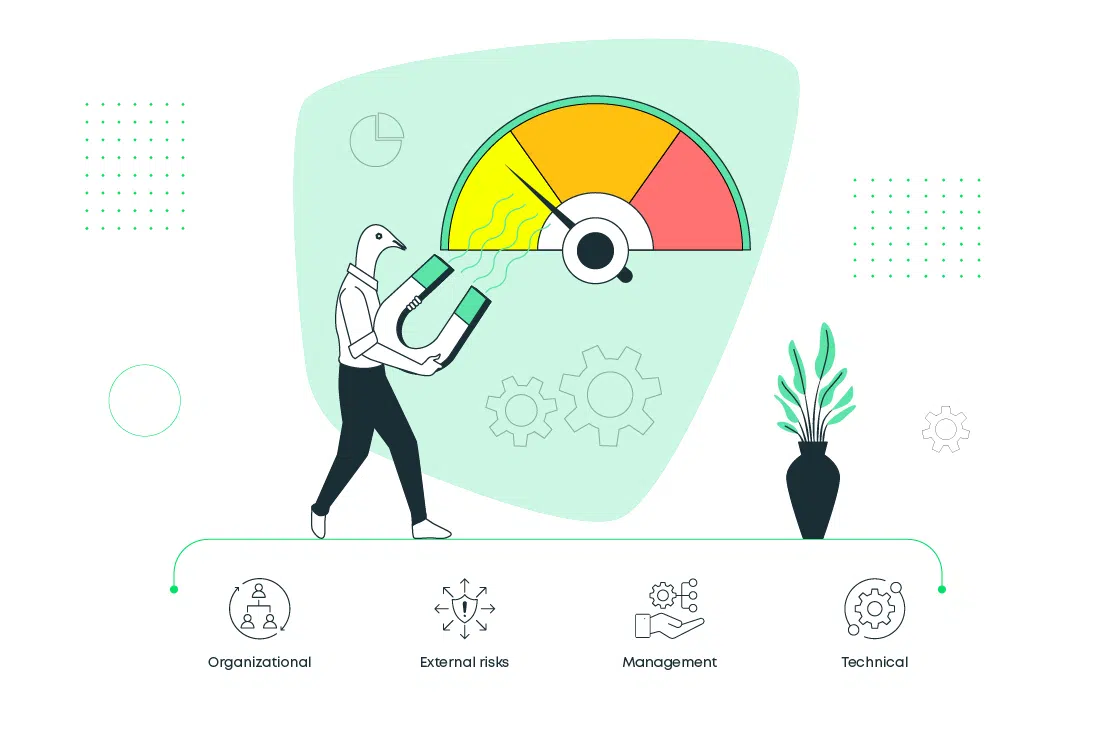Project risk management is an integral part of every organization. Even with years of project management expertise and meticulous planning, some things may still go wrong and cause havoc in your company.
You or your team can’t completely prevent or control some hazards. This is one of the most significant parts of your primary responsibilities as a project manager, ensuring that initiatives are on pace to meet their objectives.
If you are wondering, how then can you and your team manage unforeseen project risks? The answer is risk planning through analytics and data management.
Globe News Wire estimates that by 2030, the market for data analytics would be valued at 346.24$ billion with a CAGR of 30.7 percent.
Risk management through data analytics and data management is essential to the successful implementation of projects. While you can’t always prevent issues, you can plan ahead to minimize disruption to your project timeline.
In this article, we shall outline the four stages for setting up a successful risk mitigation plan that will assist in ensuring that your projects are finished within the designated timeframe and as efficiently as possible.
You have come to the right place if you don’t know what the project risk management process involves or have no idea how to start managing project risk.
Table of Contents:
Project Risk Management: An Overview
The activity of detecting, assessing, and dodging or minimizing threats to a specific project that has the probability to affect the anticipated results is known as project risk management
Normally, the project managers are in charge of supervising the risk breakdown structure and procedure during the entire course of a specific endeavor.
Project managers need a strong grasp of their goals in order to spot any potential roadblocks to the group’s capacity to achieve outcomes and manage risk efficiently.
Using analytical tools and methodologies can make the process a lot simpler and quicker.
Let’s look at the types of risks in project management.
Most project risks fit into one of many major categories:
-
Organizational: Every project dependence i.e., logistics, reserves, wealth, etc. is incorporated into this category.
-
External risks: External risks include any kind of project risk posed by your clients, end users, suppliers, or the market situation as well.
-
Management: It is one of the major categories which covers any risk log associated with appraising, organization, scheduling, or collaboration.
-
Technical: This project risk covers hazards related to technological specifications, quality, the technology utilized, functionality, and interfaces.
No matter how precisely planned your project is, there are a few risks that can cause hindrances to a successful implementation.
These typical project risk sets consist of:
-
Schedule
-
This incorporates the probability of unforeseen schedule difficulties, such as situations occurring that cause interruption in the project. Schedule conflicts and project postponements are frequently caused by scope creep.
-
-
Performance
-
It is the likelihood that something may happen to make the project’s results differ from what was designed and planned.
-
-
Cost
-
The possibility of budget-related events, particularly those that result in the budget overshooting the actual cost estimated initially, can lead to project overruns.
-
The risk register example, in this case, will be when the managers or team makes errors in cost prediction and or the designed cost structure simply gets impacted by unforeseen external events or causes.
-
-
What you need to keep in mind is that project risk management is a continuous process. Several potential dangers might materialize depending on what the project structure and process entail.
-
To give you another risk register example, the managers involved in the project will have to make plans to address the risk log related to testing, execution, coaching, and other issues.
-
-
The first step in risk management in project management is for project managers to determine which risk categories are of particular significance. Take the scope and depth of every category of project risk into account concerning the entire venture.
-
This will allow them to comprehend the potential consequences of these threats on project results and design the risk breakdown structure to lessen them.
-
Risk Management in Project Management: 4 Steps
Let’s explore the 4 steps of project risk management that are being used by several organizations and are extremely efficient in managing risks.
Identifying the different types of risk in project management
The initial and arguably most crucial stage is to detect and recognize the risk as quickly as possible.
The project risks can be quite simple to eradicate or decrease in the early phases. However, if you or your team ignore them, it might result in a disastrous unrepairable state.
-
Decide which types of risks in project management are important to address for your project to run successfully.
-
To achieve this, you can make use of analytical tools or resources like checklists, research surveys, meetings, or brainstorming sessions. The threats are often recorded in a project risk register.
-
When you are decoding the risks, it’s extremely crucial to include experts who have thorough knowledge.
-
To ensure the identification of risks at early stages, you need to set up frequent supervision days. During these phases, you’ll need to evaluate every specific detail and process of the project.
This will help you to work on the potential risk log for every corrupted aspect that might potentially harm a successful implementation.
Assess: Analyze and Evaluate
The next step in risk management in project management is analyzing and evaluating the risks identified.
You must ascertain the impact of the risk on the project. Once you’ve detected the threat, it’s time to investigate it.
-
What level of risk are you working with?
-
What type of risk is it?
-
What will be your risk mitigation plan to prevent it? Is there a way you can alter your strategy to do so?
-
Additionally, you should evaluate the risk’s repercussions. What can occur if your team sticks to the plan exactly as it is? The possibility that the risk will turn out to be irreversible.
These kinds of questions will assist you in determining if you need to take the appropriate steps to counter risks or not.
Two factors are commonly used for this: the likelihood of the risk and the impact it will have. The outcome is known as the risk exposure or degree of risk and is obtained by merging the two factors.
-
Risk impact describes how significantly a threat will harm your project if it materializes, whereas risk likelihood describes how apparent the threat is.
-
Although some supervision requirements, even when we are dealing with big data, demand quantitative evaluation, it is typical to evaluate these factors qualitatively (high, medium, low).
Action-oriented response
Most types of risk demand a suitable, doable, and economical solution. The answer will be heavily influenced by the degree or intensity of risk involved.
A low-altitude risk, for instance, you could decide to just acknowledge, but a complex risk necessitates a more forceful reaction.
Here are a few potential risk reactions:
-
Preventing the risk by refraining from engaging in the task that leads to the threat
-
Acceptance of the threat and any negative effects it will have or has had on the project
-
Modifying the likelihood or effect of the threat using a risk mitigation plan
-
Transference of the threat to a different party
A response plan is often needed to carry out the tasks or actions once it has been determined with a risk breakdown structure.
Even if it’s a minor action. any chance of a potential risk must be met with a response.
Monitor: a continuous process
A crucial component of the project supervision plan needs to include project risk management, which is not a one-time event but rather a continuous practice.
-
Depending on your project, you can hold a weekly or fortnightly meeting.
-
At times a few projects might need frequent risk reporting, so you need to schedule it accordingly.
-
The project risk register with the risk log uncompromisingly needs to be uninterruptedly monitored.
-
New risks have to be added as they materialize, risk breakdown structure and assessments should be updated as more information becomes available, and the risk mitigation plan needs to be tracked for development.
-
The greatest defensive strategy is to do everything possible to attain a result that is as near to a hundred percent. Ultimately, you won’t manage to protect your company or fight against all the risks completely.
Keep in mind that risk is by its very nature unpredictable, and managers must be flexible and meticulous enough to adjust to changes as they arise.
Conclusion
Although it might be challenging, project risk management can be accomplished effectively. It is your responsibility as a manager or a leader to protect your team against the project risks that can arise internally or externally.
The key to a strong risk mitigation plan is to keep a watchful eye out for prospective threats and plan routine scrutinizing and evaluations.
Outsourcing analytics and data management services can help address all kinds of risks more effectively and eliminate them at the earliest stages of the project.
Speak with our specialists to learn more about how big data analytics services can transform your company and meet specific project requirements.
You can browse through our portfolio to learn more about our data analytics services and data insights solutions.
Ready to work on a solid risk mitigation plan? Contact us now!













 How Financial and Accounting Services by BluEnt Drive Business Growth in the Digital Era?
How Financial and Accounting Services by BluEnt Drive Business Growth in the Digital Era?  Secure Gift Cards: Top Tips and Strategies’ to Safeguard Personal Information
Secure Gift Cards: Top Tips and Strategies’ to Safeguard Personal Information  Cloud Data Engineering: Infrastructure and the Road Ahead
Cloud Data Engineering: Infrastructure and the Road Ahead  Real Time Analytics: Facets, Insights, and Use Cases
Real Time Analytics: Facets, Insights, and Use Cases 
